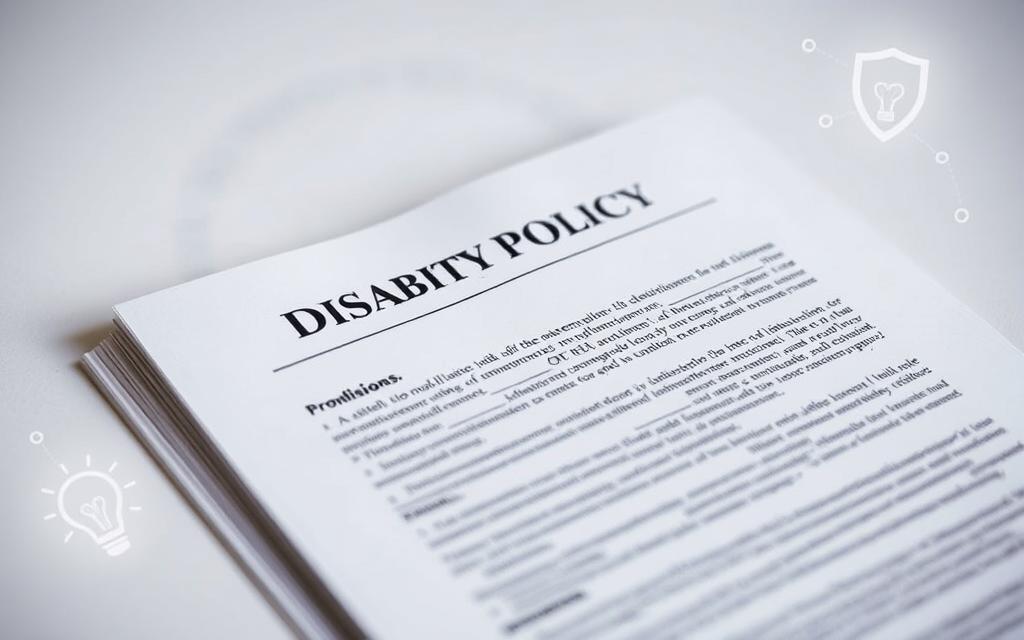Disability is something you do not wish to think about because of its uncertainties and unfortunate happenings but here lies the importance of having insurances. This guide will provide information about the different types of disability coverage, their need, and how they will further enhance your financial plan. Disability insurance is there to substitute income when one is subjected to work disabling conditions such as injury or disease. This is an important type of insurance that gives you a relief when things go south. Being informed about the available options and their pros will save you some money. We will elaborate on the main points of critical disability insurance, like time frame, conditions one should meet, and expenses associated. In the end, you will understand how to select suitable disability insurance considering all the available options.
What Is Disability Insurance and Why You Need It
It would be a great understatement to say that the construction industry does not face dangers or hurdles when carrying out the necessary duties. In such a case, coverage cannot be gained from any other protection than disability insurance. It helps you pay bills when your normal earning is cut off as a result of permanent or temporary disaster. Letting such a condition happen without appropriate coverage is financially reckless.
Short-term vs. Long-term Coverage Options: Insurance can be further broadly categorized into two categories, short term and a long-term coverage plan. Polices under short-term can sustain between weeks and months while under the long-term plan, it can go on for a lifetime depending on the policy taken by the insured party.
Key Advantages of Seeking for Disability Cover:
- Ensure that your income replacement is preserved during periods of work incapacity
- Access disability payments to meet basic necessities
- Acquire guarantees against the monetary impact of being disabled
- Preserve your families’ economic stability
Disability risks: The lack of insurance for the disabled can put one at a great deal of risk. One event that leaves you disabled may completely drain your reserves. You may be forced to resort to family or friends for cash or become homeless. Obtaining coverage for disability is something that is quite wise of an individual.
| Coverage Type | Benefit Duration | Key Considerations |
|---|---|---|
| Short-term Disability | Typically 3-6 months | Provides quick income replacement, but limited coverage duration |
| Long-term Disability | Potentially years or until retirement | Offers extended income replacement and disability benefits, but may have higher premiums |
“Disability insurance is a critical safeguard that can protect your most valuable asset – your ability to earn an income.”
Types of Disability Insurance Coverage Available
There are many types of policies available that provide some income protection in case a person becomes disabled. Two main options are own-occupation and any-occupation policies. Depending on the needs of the client, these basically differ in terms of benefits and coverage.
Own-Occupation Policies: These policies pay out if you can’t do your job even if you are able to do another job. These policies are very ideal for people who are qualified in very specific occupations. Such people may have difficulty within the same occupational area if they become disabled.
Any-Occupation Policies: An insured is rendered incapable of any work which he is a qualified individual to perform so such policies compensate. These policies are cheaper in nature but do not have as high coverage as own-occupation policies. Another option is group disability policies sponsored by employers. It is more inexpensive and easy to acquire. due to these advantages, many employees find it attractive.
| Policy Type | Key Benefit | Potential Drawback |
|---|---|---|
| Own-Occupation | Provides benefits if unable to perform specific job duties | Generally more expensive premiums |
| Any-Occupation | Typically more affordable premiums | Benefits only payable if unable to work in any suitable occupation |
| Group Disability Insurance | Employer-sponsored coverage with streamlined application | Coverage may be limited compared to individual policies |
When choosing disability insurance, think about your needs, job, and budget. A financial advisor can help you pick the best policy. This way, you can protect your financial future.
How Disability Insurance Works in Epic Proportions
Disability insurance would seem complicated from the onset to many. However if an individual understands the process of submitting a claim, the waiting times involved, along with how the benefits are disbursed and received, it can be made easier. Let’s examine how the state of affairs actually plays out in practice with respect to the disability insurance.
Disability Claim Submission Guidelines: For all individuals out there who are considering filing for a disability claim, the first course of action that must be taken is to notify your insurance provider. One will be required to fill a form detailing the claim in addition to submitting relevant medical records. How one proceeds to file the claim will always be specific to one’s policy, and thus the need to refer to the guidelines.
Waiting Periods and Schedule of Benefit Payments: An elimination policy is available with almost all policies. This is the minimum period with in which an individual must be immobilized permanently before accessing the benefits. This waiting period can be anywhere in the range of 14 days to 6 months, as per the terms of the policy. This elimination time commenced, the insurer will begin to make the payout, which is usually a portion of one’s income that would have been earned if not disabled.
Time Limits for Payments: For disability insurance, the average payout is in the region of two years with some extending till the beneficiaries age of retirement. The specific policy taken out will determine the length of cover. It is very important and wise to understand such policies in order to ascertain that in case of long term disabilities, one will be able to still incur some gains from the insurance policy taken out.
| Benefit Feature | Short-term Disability | Long-term Disability |
|---|---|---|
| Elimination Period | 7-14 days | 90-180 days |
| Benefit Duration | 3-6 months | 2 years, 5 years, or until retirement age |
| Benefit Percentage | 60-70% of pre-disability income | 50-60% of pre-disability income |
By understanding how disability insurance functions, you can be better prepared for the process of filing a claim. In such a case, you will be able to receive the benefits that you deserve after you have suffered a sort of permanent disability.
Terms pertaining to your disability insurance policy
Disability insurance is essential, and it is crucial to be familiar with your policy terms. This side has to be complicated, yet it is critical to comprehend it. This helps guarantee that you have the appropriate insurance. We will break down the basics so that you can make informed decisions about your policy.
Policy Provisions: What is covered by your policy as disability insurance is addressed in policy provisions. They explain what constitutes a disability, the waiting period for benefits, and the duration of annuity payments. If you are aware of such information, it is possible to avoid any shock in circumstances which call for claiming the benefits.
Exclusions and Limitations: As a rule, insurance has exclusions and limitations. These might include pre-existing conditions or injuries caused by engaging in high-risk measures. These are critical since they ensure the efficacy of your policy.
Definitions: Insurance companies have their definitions for policy endorsement. It includes total disability and partial disability. Therefore, total disability will determine the benefits you’ll get and the other factors that partial disability would. This policies evaluation is beneficial in that, having made such reviews, it can be established whether the insurance policy is adequate. Knowing all the details regarding your disability insurance policy can help you secure your finances in the unfortunate event of an illness or injury. Understanding your policy is quite useful.
| Policy Provision | Description |
|---|---|
| Definition of Disability | The criteria used to determine if a policyholder is considered “disabled” and eligible for benefits. |
| Waiting Period | The time period between the onset of a disability and the start of benefit payments. |
| Benefit Duration | The maximum length of time that disability benefits will be paid, typically expressed in months or years. |
| Exclusions | Specific conditions or circumstances that are not covered by the disability insurance policy. |
| Limitations | Restrictions on the types or amounts of benefits that can be paid under the policy. |

Appropriating The Conditions Hence Which One Can Qualify For The Disability Allowance.
Knowing what qualifies as a disability is important. The coverage of a disability insurance policy can be pretty broad. It can include physical disabilities, mental disabilities, chronic diseases, and so on which make the victim unable to work and earn a living.
Coverage Of Physical Disabilities: There are also many physical disabilities that can be classified under the category of “disability insurance”” One of them is one or more musculoskeletal disorder, a neurological disorder, or one of the sensory disorders. For instance, back pain, arthritis of the spine and eyes or ears.
Policies also include coverage concerning accidents of loss of limbs etc, this may also involve tearing of the spinal cord.
Mental Conditions: There are of course conditions like depression or post-traumatic stress disorder but in this case depression will steadily now be in the policies of more insurers. Other providers may include diseases like anxiety and PTSD in their insurance rates but still lie as lioness in wait.
Chronic Illnesses: That being said some indeed chronic diseases such as malignancy, stroke, obesity diabetes may also qualify the association for loss of income benefits. Such diseases will always require treatment making it hard for the patient to earn a living. Support insurance eases the burden of bearing the cost during treatment and recovery. Of course it goes without saying the terms and conditions of a policy must always be read with a fine tooth comb. This will guarantee that money is always put to good use. And seek the advice and assistance of an insurance policy expert.
| Covered Disabilities | Examples |
|---|---|
| Physical Disabilities | Musculoskeletal disorders, neurological conditions, sensory impairments |
| Mental Health Conditions | Depression, anxiety, PTSD |
| Chronic Illnesses | Cancer, heart disease, diabetes |
Cost Factors of Disability Insurance Premiums
Disability insurance premiums may vary a lot depending on a couple of essential elements. Understanding these factors helps people get a reasonable cover without breaking the bank. Let us see what influences the amount of money that is paid for disability insurance.
Age and Occupation: Your age determines the particular amount of money that you will pay for the disability insurance. Younger individuals usually have a lower insurance fee as they are less likely to have the need for the insurance. What you do for a living also matters. If the work is hazardous, for example, construction or doing sports, then your premiums will rise.
Health Status and Lifestyle: Your health is in a way also a big contributor to your insurance costs. If you have an existing illness or have some history of being sick, you can be charged higher. There are lifestyle choices such as smoking which have an impact on the charges that one will pay.
Policy Features and Coverage Limits: The particulars of the insurance plan that you will use also affects the cost. Other factors such as the amount you will be compensated, waiting time before receiving it, and the duration of the benefit all vary the price. It is a general principle that the more coverage and longer the duration for the benefits, the higher the cost.
| Factor | Impact on Premium Rates |
|---|---|
| Age | Younger individuals pay lower premiums |
| Occupation | Riskier occupations have higher premiums |
| Health Status | Pre-existing conditions can increase premiums |
| Lifestyle Factors | Risky behaviors like smoking can raise premiums |
| Policy Features | Comprehensive coverage with higher benefits costs more |
If you understand these factors, you will be in a good position to select the right disability insurance cover. This way, you get the protection you need at minimal costs.
Group vs Individual Disability Insurance Plans
There are two main options when securing disability insurance. You can either obtain group plans administered by your employer or get a private policy. Each of the choices has its advantages and factors that need consideration.
Employer-Sponsored Coverage Details: Most employment positions include group disability insurance in their benefits packages. Such plans are normally easy to enroll in and cost less for the employer. Unfortunately, they may have restrictions such as limited coverage periods and difficulties with portability upon changing employers.
Private Policy Advantages: You cannot compare group vs individual disability insurance without considering the private insurance option. This is because private insurance is more flexible. You can obtain the coverage comparison that you want, retain your coverage regardless of employer changes, and enjoy more benefits. The only downside is cost, but that is a small price to pay for stronger and more tailored private policies.
| Feature | Group Disability Insurance | Individual Disability Insurance |
|---|---|---|
| Premiums | Generally lower | Often higher |
| Coverage Customization | Limited | Highly flexible |
| Portability | Limited when changing jobs | Fully portable |
| Benefit Amounts | Typically capped | Can be higher |
In deciding between group and individual disability income insurance, these elements such as desired benefits, budget, and goals should be taken into consideration. Evaluating the advantages and shortcomings of the two options can assist you in determining the best cover for financial protection against disability.
SSDI and Private Insurance, what are the differences?
SSDI is one of the most important sources of support for people who, due to disability, are unable to engage in productive activities. However, it is probable that it will not be able to satisfy each of your requirements. SSDI benefits are low, and their acquisition is a complex process. Private long-term disability insurance provides more. It is usually more difficult to receive full dependent benefits; conversely, this type of insurance is easier to obtain and can be customized. Also, it is excellent as a secondary policy to SSDI, helping to cover the shortfall in finances.
It’s about income and plans for the future. Therefore, whether to stay with SSDI or find a private insurer will depend on one’s individual circumstances. Understanding both alternatives provides insurance coverage that is right for them and their families.
FAQ
How do short-term and long-term disability coverage differ?
Short term coverage may assist for a span of several months. Long-term coverage assists till you retire or recover. Short-term includes current circumstances and needs while long-term pertains long earning capacity.
What is the purpose of disability insurance policies and how do they work?
Disability insurance pays your bills and makes sure you have nothing to worry about in the future. In case of disability, it allows you to maintain your standard of living as well as provide for expenses and defer savings.
What are the consequences for not obtaining a disability insurance policy?
Without these businesses, you will make good money but fall behind and on the street and will suffer even more. These policies are a form of protection for your financial strength during disability to work.
What type of disability insurance will notice different policies around the world?
Theirs own-occupation, any-occupation and group ones. Own-occupation means that you cannot do your work anymore. Any-occupation means that you can’t work already anywhere meaning.
How do I file a claim for disability insurance and how difficult is this process?
In order to make claims, an insured must provide the insurance company with medical evidence and proof of disability. After a period of waiting in time, money starts in floods. Thereafter, within approved limits, the repayments shall be continuous ad infinitum until normalcy resumes.
What are the general constitutions and conditions exemplified in disability insurance cover?
Policies have provisions such as definitions of terms like the definition of disability, exclusions, and also the waiting periods. It is essential to be conversant with these so that one is able to get the right amount of coverage and follow any encumbrances.







